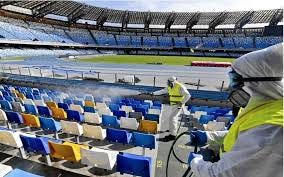Something a little different for today’s offering. A lot has been talked and written about how sport might look in the future. Much of it is corporate-speak and gobbledygook, so I have taken some time to break it down into some interesting talking points. It is important because something below will be felt by most sports fans once the pandemic is over.
Sports around the world are looking at the impact Covid-19 has had on their operations and their prospective recoveries.
Among the considerations have been whether sports and society, will ever return to 'normal'?
If it all becomes a bit too mind-boggling to comprehend, here are some factors to consider taken from a respected sports concepts magazine, Sports Pro.

For starters:
Stadium usage
Physical changes to be expected at major events will be much more orderly behaviour at stadium entry and departure.
One-way systems and crowd-monitoring technology will become commonplace in affecting crowd movement while also maintaining social distancing. Mobile ticketing, cashless payments and ordering of food and beverage from your seat will limit crowded areas while also reducing queues. And individual temperature check and other health screening at entry points will attempt to show anyone with Covid-19 symptoms.
Entry times will be staggered while social distancing will avoid bottlenecks at access points.
Also expect to become used to drones spraying corona virus-killing chemicals above crowds both indoors and outdoors.
Then:
Too much sport
One issue in 2021, is the likely clash between events postponed from 2020 and those held at their traditional time. It could result in a concertina effect occurring. Compounding that prospect is whether in the associated economic downturn will sports fans have the money to pay for TV subscriptions?
What about time to consider climate change in sport?
'A masterclass in the dynamics of a catastrophe'
One aspect of sporting recovery that has gone unnoticed in New Zealand, at least, is the creation of a United Nations group, Sport for Climate Action Framework. It is reported only about a dozen global governing sports bodies and some teams, national leagues or associations have joined the group.
But it has highlighted the effect climate could have on the future sports world.
For example, of 19 former Winter Olympic venues, only ten will remain viable sports venues by 2050 and only six by 2080.
Partial, or total, flooding could affect 23 of England's 91 professional soccer club grounds. Seven more are vulnerable in the Netherlands while major stadiums in Florida and New York will also be affected. Where does that leave Wellington's SKY Stadium?
Temperature changes will hamper traditional seasons in Oceania, Asia and the Americas.
As a result, academic and sports history David Goldblatt has called for an aggressive response from all Rights holders towards developing 10-year plans to achieve carbon-zero events by 2030. If sports cannot do that then their events should be postponed.
Goldblatt said the coronavirus pandemic was 'a masterclass in the dynamics of catastrophe'.
Rightsholders were off the pace and only 17 per cent felt they were capable of delivering environmentally sustainable events.
Sian Jenkins, an associate director of The Sports Consultancy, said: "Sport and climate change are inherently contradictory if you think about it and, I think, as people operating in sports we're part of the problem, but we're also part of the solution, I hope.
"Sport does bring people together, but ultimately that means people travelling, a lot of power usage, the infrastructure that's used, the waste that's generated."
Some sports have addressed the issue. Formula One will be a carbon-zero operation by the end of the decade while World Athletics has a detailed policy in place.
What has the coronavirus cost sport?
It is estimated the global sports industry revenues will drop from $US135 billion to $US75 billion in 2020, although there is a chance that could be reversed if full-scale events return during 2021.
Two Circles chief executive Gareth Balch said: "If you place an assumption on no sharp second peak, third or fourth or greater peaks in the coronavirus pandemic forcing further lockdown interventions or greater separation in society, if you assume that doesn't happen, then we're very bullish based on data that the market will return pretty quickly with an over-demand on what we'd normally like and then a revision to at least similar demands to what we've seen before.
"And therefore, sport's special spot in society will be reinforced through this period of absence as opposed to people having moved on and taken up different hobbies. We're really, really bullish about that being the case."
It is expected that in some instances sport will be better placed to make a faster recovery than other entertainment sectors, where film and television's filming is affected by social distancing demands, as are live music and theatre events.
That provided a chance for sports to be innovative and to move from being singular, broadcast-based business to being digital, interactive and appealing personally to fans, Balch said.
Finally:
Television's future
Two areas expected to grow in the wake of television coverage being accelerated through the pandemic from 2020 into 2023, as one expert put it, are documentaries and non-live intellectual property. A survey showed that 42 per cent of viewers want easy access to archive footage, 66 per cent want more live sport on free-to-air, 21 per cent want live streaming via social media and 20 per cent wand more personalised content and features.

